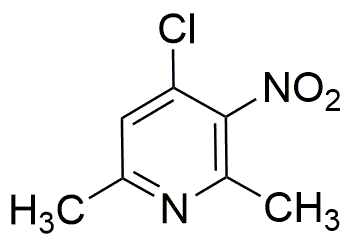4-Chloro-2,6-dimethyl-3-nitropyridine is widely utilized in research focused on:
- Agricultural Chemistry: This compound serves as an intermediate in the synthesis of various agrochemicals, including herbicides and pesticides, helping to improve crop yield and protect against pests.
- Pharmaceutical Development: It is used in the synthesis of pharmaceutical compounds, particularly those targeting neurological disorders, providing a pathway for developing new medications.
- Dyes and Pigments: The compound is involved in the production of specialized dyes, enhancing colorfastness and stability in textiles and coatings.
- Material Science: It can be utilized in the development of advanced materials, such as polymers and composites, offering improved properties like durability and resistance to environmental factors.
- Analytical Chemistry: This chemical is employed as a reagent in various analytical techniques, aiding in the detection and quantification of other substances in complex mixtures.
General Information
Properties
Safety and Regulations
Applications
4-Chloro-2,6-dimethyl-3-nitropyridine is widely utilized in research focused on:
- Agricultural Chemistry: This compound serves as an intermediate in the synthesis of various agrochemicals, including herbicides and pesticides, helping to improve crop yield and protect against pests.
- Pharmaceutical Development: It is used in the synthesis of pharmaceutical compounds, particularly those targeting neurological disorders, providing a pathway for developing new medications.
- Dyes and Pigments: The compound is involved in the production of specialized dyes, enhancing colorfastness and stability in textiles and coatings.
- Material Science: It can be utilized in the development of advanced materials, such as polymers and composites, offering improved properties like durability and resistance to environmental factors.
- Analytical Chemistry: This chemical is employed as a reagent in various analytical techniques, aiding in the detection and quantification of other substances in complex mixtures.
Documents
Safety Data Sheets (SDS)
The SDS provides comprehensive safety information on handling, storage, and disposal of the product.
Product Specification (PS)
The PS provides a comprehensive breakdown of the product’s properties, including chemical composition, physical state, purity, and storage requirements. It also details acceptable quality ranges and the product's intended applications.
Certificates of Analysis (COA)
Search for Certificates of Analysis (COA) by entering the products Lot Number. Lot and Batch Numbers can be found on a product’s label following the words ‘Lot’ or ‘Batch’.
*Catalog Number
*Lot Number
Certificates Of Origin (COO)
This COO confirms the country where the product was manufactured, and also details the materials and components used in it and whether it is derived from natural, synthetic, or other specific sources. This certificate may be required for customs, trade, and regulatory compliance.
*Catalog Number
*Lot Number
Safety Data Sheets (SDS)
The SDS provides comprehensive safety information on handling, storage, and disposal of the product.
DownloadProduct Specification (PS)
The PS provides a comprehensive breakdown of the product’s properties, including chemical composition, physical state, purity, and storage requirements. It also details acceptable quality ranges and the product's intended applications.
DownloadCertificates of Analysis (COA)
Search for Certificates of Analysis (COA) by entering the products Lot Number. Lot and Batch Numbers can be found on a product’s label following the words ‘Lot’ or ‘Batch’.
*Catalog Number
*Lot Number
Certificates Of Origin (COO)
This COO confirms the country where the product was manufactured, and also details the materials and components used in it and whether it is derived from natural, synthetic, or other specific sources. This certificate may be required for customs, trade, and regulatory compliance.


